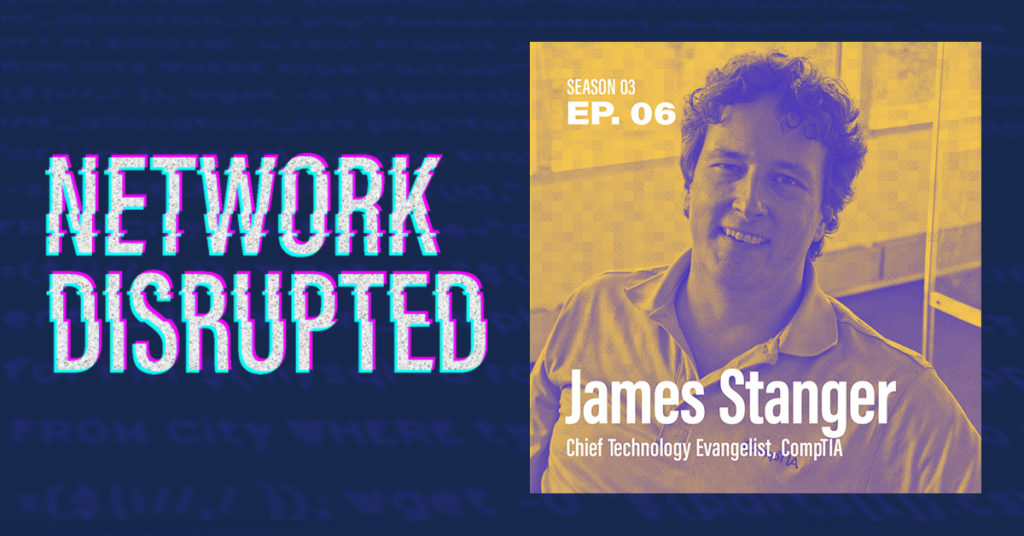Shift to cloud is shifting IT skill and training needs, too
CompTIA Chief Technology Evangelist James Stanger discusses why IT professionals need automation skills and how to take control of your own learning.

As enterprises move to the cloud, the transformation is also playing out in one other noticeable place: training and certification.
The days when a system admin or network engineer could focus solely on data center networking are waning. Technology platforms have shifted and so have the necessary skills.
Enterprises need to keep up with industry trends and IT professionals want to remain relevant in a shifting job market. As a result, there’s a booming demand for training in areas like cloud, cybersecurity, and automation.
For the sixth episode of the third season of the Network Disrupted podcast, host and BlueCat Chief Strategy Officer Andrew Wertkin chatted with James Stanger, CompTIA’s Chief Technology Evangelist. CompTIA is one of the IT industry’s largest trade associations, offering training and education, certifications, and market research.
Stanger and Wertkin discussed how the cloud is transforming the career pathway for IT professionals. Further, they delved into how the shift to the cloud has left some behind and the importance of having skills in the entire IT stack, including development automation and data analysis. Finally, Stanger offered tips both for leaders to embrace the shift and for individuals to take control of their own learning.
The IT professional career pathway: a shift is underway
CompTIA has awarded more than 2.5 million certifications in areas such as cybersecurity and networking. But Stanger says that their research has led them to emphasize the idea of an overall IT professional career pathway.
“Not just necessarily in cybersecurity or not necessarily just in help desk. But what does it mean as an IT professional to get the latest and greatest skills? And to identify areas where you might be a bit weak and how to strengthen those things up,” he says.
The advent of cloud computing has caused a notable shift in education needs.
“We’ve been talking about the cloud for a long, long time. But it’s only been in the last five years, I would say, that true implementation, for example, has been happening,” Stanger says. “It’s been neat to see people making changes there. You can call it transformation—call it what you want—but it’s interesting to see people actually adopting these things.”
Wertkin notes that cloud implementation has also upset the traditional mentorship dynamic. Someone who has worked in core networking for 20 years showing the ropes to a less-experienced team member is becoming more of a rarity.
“In the world of cloud—and in many cases in the world of cybersecurity as well—some of these skill sets are so new or still so changing. There’s not necessarily those people with the wisdom to act as a mentor,” Wertkin added.
Even with the cloud, there are still haves and have-nots
Wertkin noted that one of the great benefits of cloud computing is how much it has reduced barriers to entry for those wanting to learn.
Gone are the days when you had to obtain access to a mainframe computer or buy an expensive workstation to train yourself on. By and large, cloud technology is available at your fingertips to experiment with—at little to no cost.
Still, Stanger noted that barriers remain for those with limited means. For example, high-speed broadband internet access isn’t available everywhere.
CompTIA’s foundation, Creating IT Futures, helps address those gaps. It offers free on-ramps for people in underserved populations to prepare for and succeed in IT fields.
“You have to be very careful with that saying, ‘Well, democratization of IT, everybody has it.’ There are still a lot of haves and have-nots,” Stanger says. “A lot of have-nots.”
IT skills now include development automation
There are growing expectations for IT professionals to have knowledge of the full IT stack. Traditional system or network admins and network engineers are increasingly expected to have skills in development automation, such as Ansible or infrastructure as code. Likewise for the cloud and cybersecurity, Stanger says.
However, he has observed that people tend to think that these skill sets are still someone else’s responsibility or overestimate their own expertise in them.
“It’s a human tendency,” Stanger says. “We have knowledge in this, and then there’s something over here we don’t have as much knowledge of, and we exaggerate our knowledge in that area. It’s very, very common.”
He offered the example of how standing up servers in a server room, a basic system admin role, has changed.
“What we’re seeing is a lot of people who are saying, ‘We need more and more people to realize that they have to actually create scripts that start with those funny little curlicues and end with the curlicues. And the syntax has to be right,” he says. “That’s how you launch a server these days.”
It’s no longer enough to just log in to a hypervisor directly and create virtual machines, Stanger adds.
“You have to actually create code,” he says. “And that’s definitely something that server admins are realizing they have to do, for example, to move from that world into a more scalable world.”
Putting the information back into IT
But it’s more than just raw skills in cloud or infrastructure as code, Stanger says. Just like Ryan Patterson uses metrics to drive automation decisions, the ability to analyze information has become crucial.
IT people, more and more, need to learn about how data works and what it means to turn data into information.
“What does it mean to become somebody who really can say, ‘Well, look, if you give me a data set, I could probably find a valid trend or two?’ That’s increasingly becoming the purview of people who are [in] information technology,” he says.
“The information’s coming back into information technology,” Werkin adds.
A little bit of coding goes a long way
Wertkin noted that no matter whether you work in finance, HR, or IT, the ability to write software now could pay dividends for your career. Particularly if you can manipulate data for analysis and draw conclusions.
Stanger noted that people might think Python is just for security tools, for example.
“Well, no. You can use Python all the way across the board. It just depends on how you use it,” Stanger says. “Understanding JSON, XML—those aren’t just front-end developer, back-end developer things anymore. That’s how you manage so many different things.”
Take control of your own learning
Stanger offered tips for both leaders and individuals to embrace a culture of learning that recognizes the current shift.
First, he says, leaders can do a better job of incorporating learning into the workday. It shouldn’t be something that only occurs during designated training times. The advent of online, self-paced learning makes that much easier to do.
Furthermore, managers must acknowledge that there are multiple learning paths that any one person can take.
“What’s really cool about IT is, there are lots of forks in the road,” Stanger quips. “It’s almost infinite. And you have to find what works for you and the company.”
He says half his day is spent helping companies to develop corporate learning plans. However, an increasing share of that remaining half is now spent working with individual learning consumers. Most commonly, he says, individuals come with a directive from their employer and a budget to spend.
To that end, Stanger emphasizes that individuals should own their learning and development.
“Part of that is not to shut down possibilities,” he says. “To take control of your learning and think about that is actually to start saying, how can I reach out to people—whether it be from family to your workspace or whatever—to actually bring in better learning opportunities for yourself.”




